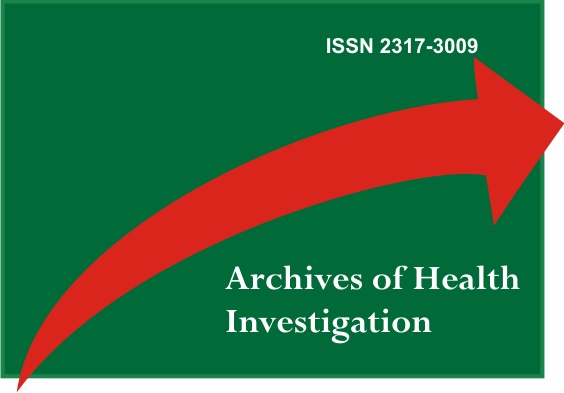Bisphosphonate-Induced Osteonecrosis in Jaw: Case Report
DOI:
https://doi.org/10.21270/archi.v11i1.5523Keywords:
Jaw, Diphosphonates, MandibleAbstract
The use of bisphosphonate is associated with bone necrosis of the jaws, a condition secondary to the drug's mechanisms of action, resulting in anti-osteoclastic and anti-angiogenic activities, altering bone metabolism, inhibiting resorption and decreasing tissue renewal. This article aims to report a case of bisphosphonate-induced osteonecrosis in the mandibular retromolar area of a 76 years old female patient, user a removable prosthesis who has been using Alendronate sodium for over 20 years for the treatment of osteoporosis. The intraoral examination revealed a sessile nodular lesion, painless, soft consistency, irregular shape and surface, erythematous color in the central area, measuring 1.5 x 0.6 x 0.5 cm, located in the lower left alveolar ridge, with four months of evolution. The tomography showed an area of cup resorption. An excisional biopsy of the superficial lesion was performed, showing a clinical appearance of parulide and the material was submitted to histopathological examination, which revealed epithelium with hyperplastic and atrophic areas, with foci of disorganization due to polymorphonuclear exocytosis and, in the connective tissue, fibrinopurulent exudate and necrosis coagulative with kyorrhex, in addition to microbial agglomerates. Based on the anamnesis, imaging and histopathological examinations, it was possible to associate the clinical diagnosis of the lesion with the underlying osteonecrosis, induced by the use of bisphosphonate. The treatment instituted was surgical removal of the superficial lesion, prosthetic wear for the relief of local trauma and local low-intensity red and infrared 3 J/cm² laser therapy. The patient had no recurrence of the lesion after 1 year and 11 months of treatment.
Downloads
References
NIH Consensus Development Panel on Osteoporosis Prevention, Diagnosis, and Therapy, March 7-29, 2000: highlights of the conference. South Med J. 2001;94(6):569-73.
Sambrook P, Cooper C. Osteoporosis. Lancet. 2006;367(9527):2010-18.
McCadden L, Leonard CG, Primrose WJ. Bisphosphonate-induced osteonecrosis of the ear canal: our experience and a review of the literature. J Laryngol Otol. 2018;132(4):372.
Santos PSS, Oliveira MA, Felix VB. Bisphosphonate-induced maxillofacial osteonecrosis in osteoporotic individuals. Rev bras ortop. 2011;46(5):495-99.
Morais EF, Macedo RAP, Lira JAS, Arruda MDLS. Osteonecrose dos maxilares associado ao uso de alendronato oral em paciente sob tratamento de osteoporose. Rev Catussaba. 2016;5(1):21-9.
Ruggiero SL, Woo SB. Biophosphonate-related osteonecrosis of the jaws. Dent Clin North Am. 2008;52(1):111-28.
Marx RE. Pamidronate (Aredia) and zoledronate (Zometa) induced avascular necrosis of the jaws: a growing epidemic. J Oral Maxillofac Surg. 2003;61(9):1115-17.
Ruggiero SL, Dodson TB, Fantasia J, Goodday R, Aghaloo T, Mehrotra B et al. American Association of Oral and Maxillofacial Surgeons Position Paper on Medication-Related Osteonecrosis of the Jaw - 2014 Update. J Oral Maxillofac Surg. 2014;72(10):1938-56.
Marx RE, Sawatari Y, Fortin M, Broumand V. Bisphosphonate-induced exposed bone (osteonecrosis/osteopetrosis) of the jaws: risk factors, recognition, prevention, and treatment. J Oral Maxillofac Surg. 2005;63(11):1567-75.
Brozoski MA, Traina AA, Deboni MCZ, Marques MM, Naclério-Homem MDG. Osteonecrose maxilar associada ao uso de bisfosfonatos. Rev bras reumatol. 2012;52(2):265-70.
Rodríguez-Sánchez MDP, Statkievicz C, Mello-Neto JM, Toro LF, Bassi APF, Garcia VG et al. The Effectiveness of the Low-Level Laser, Antibiotic and Surgical Therapy in the Treatment of Medication-Related Osteonecrosis of the Jaws: A Case Report. J Lasers Med Sci. 2020;11(1):98-103.
Lee JY, Kim IR, Park BS, Kim YD, Chung IK, Song JM, et al. Effect of low-level laser therapy on oral keratinocytes exposed to bisphosphonate. Lasers Med Sci. 2015;30(2):635-43.
Tartaroti NC, Marques MM, Naclério-Homem MG, Migliorati CA, Deboni MCZ. Antimicrobial photodynamic and photobiomodulation adjuvant therapies for prevention and treatment of medication-related osteonecrosis of the jaws: Case series and long-term follow-up. Photodiagnosis Photodyn Ther. 2020;29: 101651.
Oliveira FA, Matos AA, Santesso MR, Tokuhara CK, Leite AL, Bagnato VS, et al. Low intensity lasers differently induce primary human osteoblast proliferation and differentiation. J Photochem Photobiol B. 2016;163:14-21.
Spanemberg JC, Figueiredo MA, Cherubini K, Salum FG. Low-level laser therapy: a review of its applications in the management of oral mucosal disorders. Altern Ther Health Med. 2016;22(6):24-31.
Medeiros ML, Araújo-Filho I, Silva EMN, Queiroz WSS, Soares CD, Carvalho MGF, et al. Effect of low-level laser therapy on angiogenesis and matrix metalloproteinase-2 immunoexpression in wound repair. Lasers Med Sci. 2017;32(1):35-43.
Rosa LP, Silva FC, Nader SA, Meira GA, Viana MS. Effectiveness of antimicrobial photodynamic therapy using a 660 nm laser and methyline blue dye for inactivating Staphylococcus aureus biofilms in compact and cancellous bones: An in vitro study. Photodiagnosis Photodyn Ther. 2015;12(2): 276-81.
Ruggiero SL, Fantasia J, Carlson E. Bisphosphonate-related osteonecrosis of the jaw: background and guidelines for diagnosis, staging and management. Oral Surg Oral Med Oral Pathol Oral Radiol Endod. 2006;102(4): 433-41.
Neville BW, Damm DD, Allen CM, Bouquet JE. Patologia Oral e Maxilofacial. 3.ed. Rio de Janeiro: Elsevier; 2009.
Ruggiero SL. American Association of Oral and Maxillofacial Surgeons: American Association of Oral and Maxillofacial Surgeons position paper on bisphosphonate-related osteonecrosis of the jaws-2009 update. J Oral Maxillofac Surg. 2009;67(5):2-12.
Marx RE, Cillo JE Jr, Ulloa JJ. Oral bisphosphonate-induced osteonecrosis: risk factors, prediction of risk using serum CTX testing, prevention, and treatment. J Oral Maxillofac Surg. 2007;65:2397-410.
Lin TC, Yang CY, Yang YHK, Lin SJ. Incidence and risk of osteonecrosis of the jaw among the Taiwan osteoporosis population. Osteoporosis International. 2014;25(5):1503-11.
Yarom N, Yahalom R, Shoshani Y, Hamed W, Regev E, Elad S. Osteonecrosis of the jaw induced by orally administered bisphosphonates: incidence, clinical features, predisposing factors and treatment outcome. Osteoporos Int. 2007;18(10):1363-70.
Sedghizadeh PP, Stanley K, Caligiuri M, Hofkes S, Lowry B, Shuler CF. Oral bisphosphonate use and the prevalence of osteonecrosis of the jaw: an institutional inquiry. J Am Dent Assoc. 2009;140(1):61-6.
Iglesias JE, Salum FG, Figueiredo MA, Cherubini K. Important aspects concerning alendronate‐related osteonecrosis of the jaws: a literature review. Gerodontology. 2015;32(3):169-78.
Beth‐Tasdogan NH, Mayer B, Hussein H, Zolk O. Interventions for managing medication‐related osteonecrosis of the jaw. Cochrane Database of Syst Rev. 2017;10(10):CD012432


